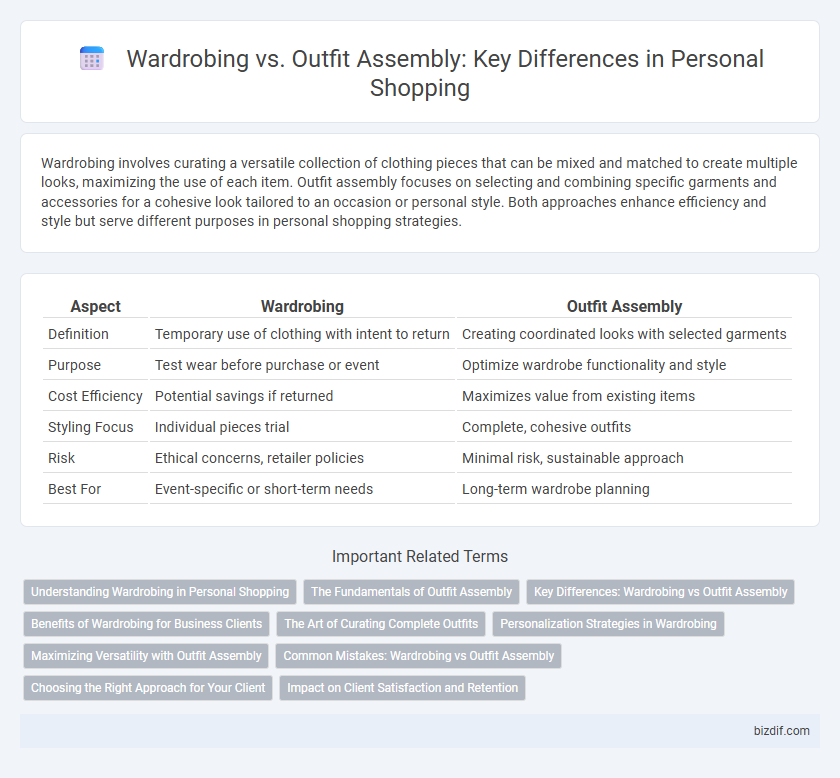Wardrobing involves curating a versatile collection of clothing pieces that can be mixed and matched to create multiple looks, maximizing the use of each item. Outfit assembly focuses on selecting and combining specific garments and accessories for a cohesive look tailored to an occasion or personal style. Both approaches enhance efficiency and style but serve different purposes in personal shopping strategies.
Table of Comparison
| Aspect | Wardrobing | Outfit Assembly |
|---|---|---|
| Definition | Temporary use of clothing with intent to return | Creating coordinated looks with selected garments |
| Purpose | Test wear before purchase or event | Optimize wardrobe functionality and style |
| Cost Efficiency | Potential savings if returned | Maximizes value from existing items |
| Styling Focus | Individual pieces trial | Complete, cohesive outfits |
| Risk | Ethical concerns, retailer policies | Minimal risk, sustainable approach |
| Best For | Event-specific or short-term needs | Long-term wardrobe planning |
Understanding Wardrobing in Personal Shopping
Wardrobing in personal shopping involves curating a versatile wardrobe by selecting key pieces that mix and match effortlessly, optimizing clothing utility and style variety. This approach emphasizes long-term wardrobe planning to ensure each item complements others, reducing unnecessary purchases and promoting sustainable fashion choices. Understanding wardrobing allows personal shoppers to create cohesive looks tailored to individual lifestyles, enhancing client satisfaction and wardrobe functionality.
The Fundamentals of Outfit Assembly
Outfit assembly centers on creating cohesive looks by strategically combining clothing, accessories, and footwear to reflect personal style and occasion appropriateness. Unlike wardrobing, which involves periodically updating or rotating clothing items, outfit assembly emphasizes thoughtful selection and coordination of existing wardrobe pieces to maximize versatility. Mastering key elements such as color harmony, fabric texture, and garment fit is essential for successful outfit assembly in personal shopping.
Key Differences: Wardrobing vs Outfit Assembly
Wardrobing focuses on curating and organizing individual wardrobe pieces for versatile daily wear, while outfit assembly emphasizes combining multiple clothing items and accessories into cohesive looks for specific occasions or styles. Wardrobing often involves selecting staple garments based on fit and fabric, whereas outfit assembly prioritizes the visual harmony and thematic consistency of an entire ensemble. Both approaches enhance personal style but differ in scope, with wardrobing centered on garment selection and outfit assembly on creative coordination.
Benefits of Wardrobing for Business Clients
Wardrobing offers business clients a tailored approach to personal shopping by providing curated clothing options that align with their professional image and industry standards. This service enhances efficiency by streamlining the selection process, saving valuable time during busy work schedules. Access to expert styling advice through wardrobing ensures cohesive, versatile wardrobes that support confidence and brand representation in various business settings.
The Art of Curating Complete Outfits
Wardrobing emphasizes selecting individual garments that fit personal style, while outfit assembly focuses on combining those pieces into cohesive, versatile looks. The art of curating complete outfits involves understanding fabric textures, color coordination, and occasion appropriateness to create seamless ensembles. Expert personal shoppers prioritize balance and contrast to elevate everyday wear into polished, intentional style statements.
Personalization Strategies in Wardrobing
Wardrobing emphasizes personalized styling by curating wardrobe pieces that reflect an individual's lifestyle, preferences, and body type, ensuring seamless outfit adaptability. Advanced personalization strategies include using detailed client profiles and AI-driven insights to recommend versatile garments that maximize mix-and-match potential. This approach enhances long-term wardrobe cohesion and supports sustainable fashion choices tailored to unique personal aesthetics.
Maximizing Versatility with Outfit Assembly
Maximizing versatility with outfit assembly involves strategically combining key wardrobe pieces to create multiple distinct looks tailored to different occasions. Wardrobing focuses on individual garment selection, while outfit assembly emphasizes the synergy between items, enhancing functionality and style efficiency. This approach reduces wardrobe clutter and ensures each piece contributes to a cohesive, adaptable personal style.
Common Mistakes: Wardrobing vs Outfit Assembly
Common mistakes in wardrobing include overloading closets with unused or mismatched items, leading to clutter and decision fatigue. Outfit assembly errors often stem from neglecting balance in colors, textures, and proportions, resulting in uncoordinated looks. Prioritizing versatile, mix-and-match pieces prevents these pitfalls by streamlining wardrobe functionality and enhancing style coherence.
Choosing the Right Approach for Your Client
Wardrobing emphasizes building a versatile closet with curated staples that mix and match effortlessly, ensuring clients have foundational pieces suitable for various occasions. Outfit assembly focuses on creating complete, styled looks tailored to specific events or daily routines, offering clients a ready-to-wear solution without decision fatigue. Selecting the right approach depends on the client's lifestyle, preferences, and goals, with some benefiting from a flexible wardrobe while others prefer pre-assembled outfits for convenience and time-saving.
Impact on Client Satisfaction and Retention
Wardrobing focuses on curating individual statement pieces tailored to clients' preferences, enhancing client satisfaction through personalized style expression. Outfit assembly emphasizes cohesive ensembles that simplify daily dressing, improving client retention by offering practical, complete solutions. Combining both strategies maximizes satisfaction and loyalty by balancing individuality with functional wardrobe management.
Wardrobing vs Outfit assembly Infographic

 bizdif.com
bizdif.com